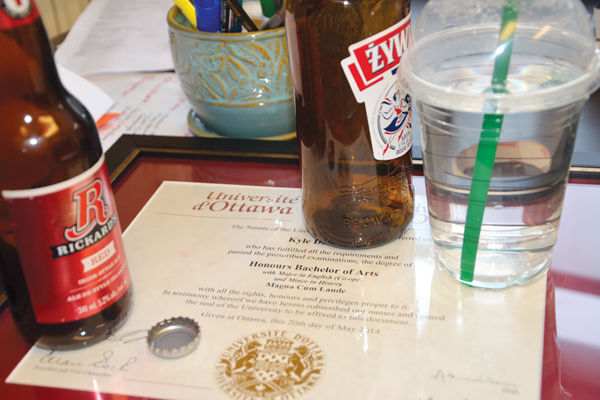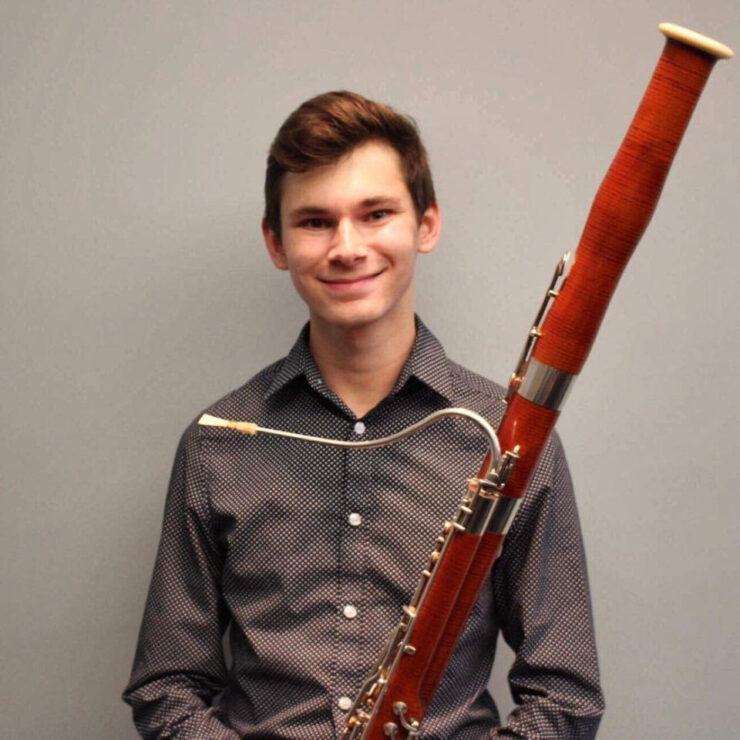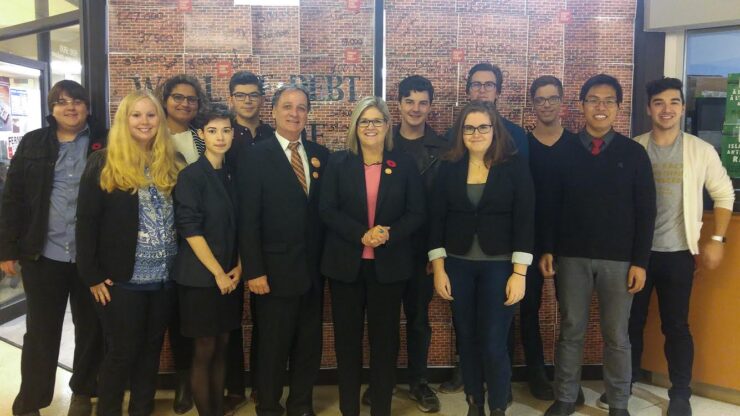The Fulcrum chats with the candidates as election day inches closer
The 2014 municipal election ballot will list eight names—a much smaller ballot than in 2010, when 20 candidates were vying for the post of Mayor of Ottawa.
Last election, Jim Watson took 48.7 per cent of the vote, with 66,000 more votes than the second-place candidate.
Jim Watson, 53, is running for his third term as mayor, and his second concurrent one. He was the city’s mayor from 1997 to 2000, and also served as a city councillor and an MPP for Ottawa West-Nepean.
Mike Maguire, 54, ran for mayor in 2010, coming fifth with 2.45 per cent of the vote. He’s running again because he believes the city has lost its way, is in deep financial trouble, and needs a change.
Bernard Couchman, 34, runs his own marketing business. He’s running because he thinks it’s an opportunity to inspire young people to reach for higher goals. He supports increasing indigenous rights and engaging the youth.
Michael St. Arnaud, 66, also ran for mayor in the last election, taking 0.08 per cent of the vote. St. Arnaud believes the city’s landlord program is in need of reform, and is making it the focus of his platform.
Anwar Syed, 54, is an engineer who wants to make Ottawa “the envy of the world.” He says his experience in various global cities and his own professional values will lead him to succeed as mayor.
Robert White, 54, is a contractor who withdrew from the 2010 race but returned this year. His goals are to balance the city’s budget, improve accountability at City Hall, and help those on low incomes.
Darren W. Wood, 45, was a Niagara Falls politician for 20 years and was originally slated to run for councillor in the Stittsville ward. He describes himself as a person who “fights for the little guy,” and wants to prevent taxes from rising.
Rebecca Pyrah is a third-year student at Carleton University. She did not respond in time for publication.
Housing
A shortage of student housing is a frequent topic of conversation at the University of Ottawa, despite a new residence opening in September on Friel Street and another under construction on Henderson Avenue. The university wants 1,200 new spots for students in the next three to four years, but finding a place for housing developments has proven a challenge.
Housing is a concern for all the candidates, but with more of a focus on low-income residents.
Watson’s housing plans are geared towards people at or below the poverty line. He said he has no specific plans for student housing because it’s the responsibility of the university. He also said the Light Rail Transit (LRT) project will allow students to live elsewhere in Ottawa while still easily accessing the campus.
Maguire said his housing platform focuses on better planning, preventing zoning conflicts, and a more proactive approach from the city. He also said he doesn’t have a special policy for the university.
The other candidates plan to work with the university if elected. Couchman wants to engage with the youth and ask for their ideas. St. Arnaud and Syed want more on-campus options available to prevent long commutes. White plans to work closely with U of O planners to find quick, equitable housing options. Wood said there are city properties in downtown Ottawa that could be converted into student housing.
Landlord licensing is also a contentious topic. Watson, Maguire, and Syed all feel it’s unnecessary, saying it will increase paperwork but not the standard of housing. Watson said that during his term, property enforcement has already been “stepped up.” Maguire also noted there are measures already in place to protect tenants. He called landlord licensing a “nightmare,” while Syed called it a “cash grab.”
The other candidates expressed interest in pursuing the idea.
Transportation
Watson’s campaign heavily supports the LRT project, which he set in motion at the beginning of his current term. The Confederation Line is currently under construction and will travel from Tunney’s Pasture to Blair. If re-elected, Watson wants to begin work on a $3 billion second phase that if completed will bring 65 per cent of residents within 5 kilometres of the track, he said.
The other candidates are critical of the second phase of the LRT. Maguire said it will never happen because of “simple finance,” putting the city billions in debt and resulting in a tax increase of 18 per cent. Instead, Maguire wants to focus on bringing the O-Train to existing rail lines at a fraction of the price.
Couchman also wants to use existing rails. St. Arnaud wants bus services expanded to lower waiting times, saying an LRT is not as convenient. The LRT is a “small solution,” according to Syed, and creating relief lines for the 417 to reduce traffic is a better plan.
White said the second phase is not planned, and encourages voters to research how the contracts are awarded to firms who donate to the Liberal Party before supporting the current plan. Wood thinks it’s a waste of money, and that transit fees will go “through the roof” if the second phase is accepted.
Candidates also have differing opinions on the U-Pass. Many students feel the U-Pass should be effective year-round and that is should be easier to opt out.
Watson said every time he’s talked to students they’ve had “nothing but positive comments.” The U-Pass is the cheapest transit pass OC Transpo offers for an eight-month period. He said he’s offered the Student Federation of the University of Ottawa (SFUO) the chance to hold a referendum for a summer pass, but hasn’t heard back yet.
Maguire said the U-Pass is a “regressive tax” by charging those who never use it. Instead, he wants to expand the OC Transpo student pass by removing the under-19 age limit. “It could be used in the summer, and only people who wanted it would have to buy,” he said. “If we applied administration costs of the U-Pass towards the expansion, it would be a reasonable price.”
Other candidates support the full-year U-Pass. St. Arnaud and White also want to focus on making transit more affordable for those on a tight budget.
Student engagement
There are 82,000 post-secondary students in Ottawa, and 40,000 of them are at the U of O. Watson has reached out to students by maintaining a presence on campus. This year he has attended Shinerama, Clubs and Societies Day, and Brain Health Awareness Week at the U of O. He also has about 100 students working on his campaign team.
Watson, Maguire, and Syed were at a debate at Carleton University on Sept. 23, each taking time to communicate with students.
Maguire said he frequently engages with students through email, canvassing, and Twitter. He said the Carleton debate offered a chance to reach many different students.
Couchman also frequents both The U o O and Carleton, and has supported student projects in the past through his company. He keeps contact through canvassing, his website, and emails. “Young people are the most important resource we have,” he said.Syed said he knows that students are busy with reading week and that studies come first, but he encourages them to come out and participate if they can.
White encourages students to get involved politically, offering his support using social media. If elected, his door will always be open to students, since they are “our future in politics and civic life,” he said.
Wood said social media and his website have been the biggest way students have reached out
to him. He tells students that municipal elections affect them more than any other level of politics.
Youth Unemployment
Some candidates have also promised to lower the youth unemployment rate. Watson said his job is to facilitate private companies coming to Ottawa to provide employment. He said initiatives like Invest Ottawa for entrepreneurs and trade delegations help create economic opportunities for the city.
Maguire said youth unemployment is a symptom of the city’s slow planning. He suggests giving private construction firms more leeway when hiring for summer jobs. He also said purchasing hydro from Quebec will allow businesses to have more overhead, increasing their likelihood of hiring.
Couchman advocates for the city providing more jobs for students. St. Arnaud feels there’s no priority given to the “educated person” when job hunting, and wants an organization to help them develop career skills.
Syed wants to sooner phase out retiring employees at City Hall to make room for young workers. White thinks students are a “neglected employee stream,” and wants to bring investments into the manufacturing and high-tech industries, the international trade, and networking opportunities to give students options.
The municipal election will take place Oct. 27.





